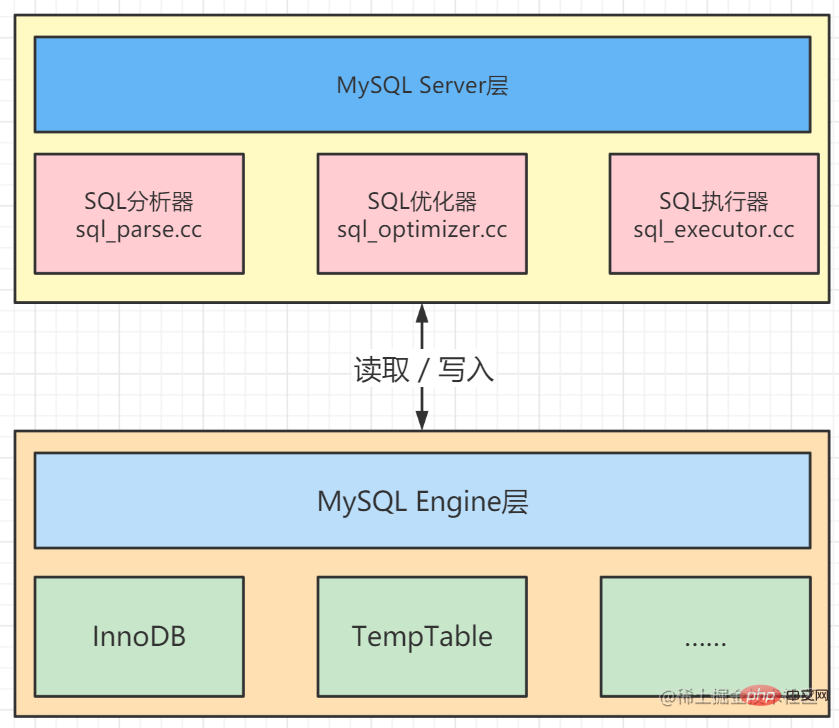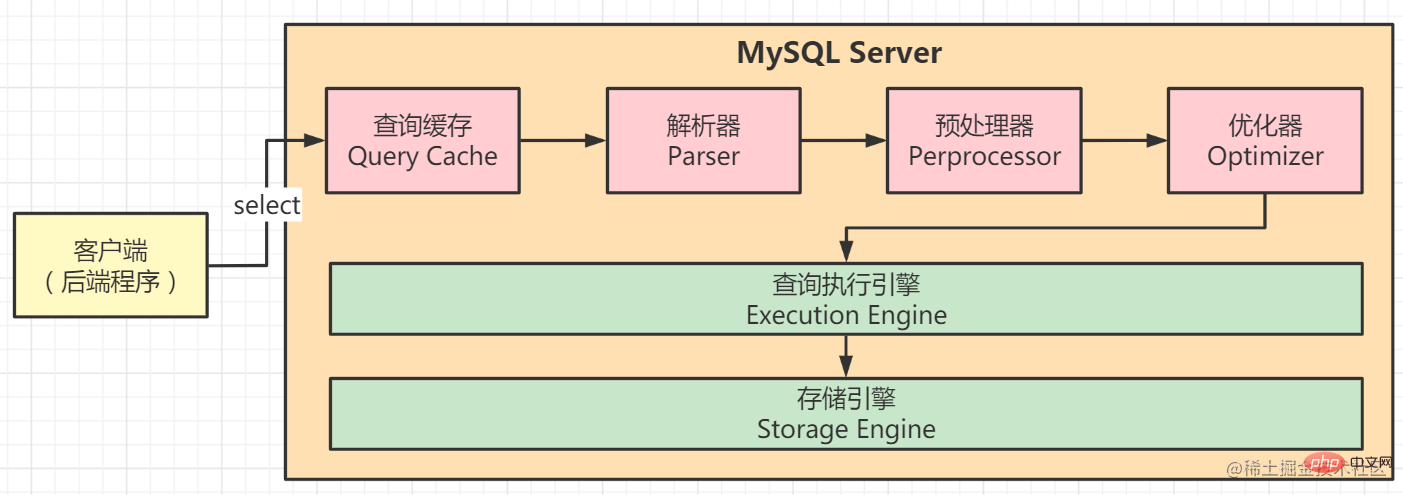In-depth understanding of how the MySQL index optimizer works
This article brings you relevant knowledge about mysql, which mainly introduces the relevant content about the working principle of the index optimizer, including the composition of MySQL Server, the MySQL optimizer selects indexes Principle and SQL cost analysis, and finally summarize the entire query process through select query. Let’s take a look at it together. I hope it will be helpful to everyone.

Recommended learning: mysql video tutorial
##1. How the MySQL optimizer selects indexes
Let’s take a look at this table. The SUB_ODR_ID field has created two related indexes. Based on what we learned before, we create a PRIMARY KEY (ID) auto-incrementing primary key index, (LOG_ID, SUB_ODR_ID) are set as joint index and unique index, and two indexes are set for CREATE_TIME and UPDATE_TIME respectively.
CREATE TABLE `***` ( `ID` bigint(20) NOT NULL AUTO_INCREMENT COMMENT '主键id', `LOG_ID` varchar(32) NOT NULL COMMENT '交易流水号', `ODR_ID` varchar(32) NOT NULL COMMENT '父单号', `SUB_ODR_ID` varchar(32) NOT NULL COMMENT '子单号', `CREATE_TIME` datetime(0) NOT NULL COMMENT '创建时间', `CREATE_BY` varchar(32) NOT NULL COMMENT ' 创建人', `UPDATE_TIME` datetime(0) NOT NULL DEFAULT CURRENT_TIMESTAMP(0) ON UPDATE CURRENT_TIMESTAMP(0) COMMENT '更新时间', `UPDATE_BY` varchar(32) NOT NULL COMMENT '更新人', PRIMARY KEY (`ID`) USING BTREE, UNIQUE INDEX `UNQ_LOG_SUBODR_ID`(`LOG_ID`, `SUB_ODR_ID`) USING BTREE, INDEX `IDX_ODR_ID`(`ODR_ID`) USING BTREE, INDEX `IDX_SUB_ID`(`SUB_ODR_ID`) USING BTREE, INDEX `IDX_CREATE_TIME`(`CREATE_TIME`) USING BTREE, INDEX `IDX_UPDATE_TIME`(`UPDATE_TIME`) USING BTREE ) ENGINE = InnoDB AUTO_INCREMENT = 1 SET = utf8 COLLATE = utf8_general_ci COMMENT = '分摊业务明细表' ROW_FORMAT = Dynamic;
1. MySQL database composition
MySQL database is composed of Server (server) layer and Engine (engine) layer. The Serve layer has a SQL analyzer, SQL optimizer and SQL executor, which are responsible for the specific execution process of SQL statements. The Engine layer is responsible for storing specific data, such as the most commonly used InnoDB storage engine, and the TempTable engine used to store temporary result sets in memory. The SQL optimizer will analyze all possible execution plans and choose the lowest-cost execution. This optimizer is called CBO (cost-based optimizer).
#2. MySQL database cost calculation
In MySQL, the calculation cost of a SQL statement is easy to understand, that is, access Database (database pages, disk) Processes data. CPU cost, which represents the calculation cost, such as comparison of index key values, comparison of record values and sorting of result sets. These operations are completed at the server layerIO cost, which represents the cost of engine-level IO. MySQL 8.0 can separately calculate the cost of reading memory IO and disk IO by distinguishing whether the table data is in memory.Cost = Server Cost + Engine Cost = CPU Cost + IO Cost
2. MySQL query cost
Check the value of each cost and the working principle of the MySQL optimizer. We execute the following SQL statement and analyze the execution process. MySQL index The selection is based on SQL execution costEXPLAIN FORMAT=json select * from test.fork_business_detail f where f.sub_odr_id = ''
{
"query_block": {
"cost_info": {
"query_cost": "1.20"
},
"table": {
"access_type": "ref",
"possible_keys": [
"IDX_SUB_ID"
],
"key": "IDX_SUB_ID",
"used_key_parts": [
"SUB_ODR_ID"
],
"key_length": "98",
"ref": [
"const"
],
"cost_info": {
"read_cost": "1.00",
"eval_cost": "0.20",
"prefix_cost": "1.20",
"data_read_per_join": "1K"
},
"used_columns": [
"ID",
"LOG_ID",
"ODR_ID",
"SUB_ODR_ID",
"CREATE_TIME",
"CREATE_BY",
"UPDATE_TIME",
"UPDATE_BY"
]
}
}
}3. SELECT execution process
How to improve MySQL query performance? First, you need to understand the entire process of SQL processing by the query optimizer. The execution process of SELECT SQL is taken as an example, as shown in the following figure:
The above is the detailed content of In-depth understanding of how the MySQL index optimizer works. For more information, please follow other related articles on the PHP Chinese website!

Hot AI Tools

Undresser.AI Undress
AI-powered app for creating realistic nude photos

AI Clothes Remover
Online AI tool for removing clothes from photos.

Undress AI Tool
Undress images for free

Clothoff.io
AI clothes remover

Video Face Swap
Swap faces in any video effortlessly with our completely free AI face swap tool!

Hot Article

Hot Tools

Notepad++7.3.1
Easy-to-use and free code editor

SublimeText3 Chinese version
Chinese version, very easy to use

Zend Studio 13.0.1
Powerful PHP integrated development environment

Dreamweaver CS6
Visual web development tools

SublimeText3 Mac version
God-level code editing software (SublimeText3)

Hot Topics
 1654
1654
 14
14
 1413
1413
 52
52
 1306
1306
 25
25
 1252
1252
 29
29
 1225
1225
 24
24
 MySQL's Role: Databases in Web Applications
Apr 17, 2025 am 12:23 AM
MySQL's Role: Databases in Web Applications
Apr 17, 2025 am 12:23 AM
The main role of MySQL in web applications is to store and manage data. 1.MySQL efficiently processes user information, product catalogs, transaction records and other data. 2. Through SQL query, developers can extract information from the database to generate dynamic content. 3.MySQL works based on the client-server model to ensure acceptable query speed.
 Laravel Introduction Example
Apr 18, 2025 pm 12:45 PM
Laravel Introduction Example
Apr 18, 2025 pm 12:45 PM
Laravel is a PHP framework for easy building of web applications. It provides a range of powerful features including: Installation: Install the Laravel CLI globally with Composer and create applications in the project directory. Routing: Define the relationship between the URL and the handler in routes/web.php. View: Create a view in resources/views to render the application's interface. Database Integration: Provides out-of-the-box integration with databases such as MySQL and uses migration to create and modify tables. Model and Controller: The model represents the database entity and the controller processes HTTP requests.
 Solve database connection problem: a practical case of using minii/db library
Apr 18, 2025 am 07:09 AM
Solve database connection problem: a practical case of using minii/db library
Apr 18, 2025 am 07:09 AM
I encountered a tricky problem when developing a small application: the need to quickly integrate a lightweight database operation library. After trying multiple libraries, I found that they either have too much functionality or are not very compatible. Eventually, I found minii/db, a simplified version based on Yii2 that solved my problem perfectly.
 Laravel framework installation method
Apr 18, 2025 pm 12:54 PM
Laravel framework installation method
Apr 18, 2025 pm 12:54 PM
Article summary: This article provides detailed step-by-step instructions to guide readers on how to easily install the Laravel framework. Laravel is a powerful PHP framework that speeds up the development process of web applications. This tutorial covers the installation process from system requirements to configuring databases and setting up routing. By following these steps, readers can quickly and efficiently lay a solid foundation for their Laravel project.
 MySQL and phpMyAdmin: Core Features and Functions
Apr 22, 2025 am 12:12 AM
MySQL and phpMyAdmin: Core Features and Functions
Apr 22, 2025 am 12:12 AM
MySQL and phpMyAdmin are powerful database management tools. 1) MySQL is used to create databases and tables, and to execute DML and SQL queries. 2) phpMyAdmin provides an intuitive interface for database management, table structure management, data operations and user permission management.
 Oracle's Role in the Business World
Apr 23, 2025 am 12:01 AM
Oracle's Role in the Business World
Apr 23, 2025 am 12:01 AM
Oracle is not only a database company, but also a leader in cloud computing and ERP systems. 1. Oracle provides comprehensive solutions from database to cloud services and ERP systems. 2. OracleCloud challenges AWS and Azure, providing IaaS, PaaS and SaaS services. 3. Oracle's ERP systems such as E-BusinessSuite and FusionApplications help enterprises optimize operations.
 MySQL vs. Other Programming Languages: A Comparison
Apr 19, 2025 am 12:22 AM
MySQL vs. Other Programming Languages: A Comparison
Apr 19, 2025 am 12:22 AM
Compared with other programming languages, MySQL is mainly used to store and manage data, while other languages such as Python, Java, and C are used for logical processing and application development. MySQL is known for its high performance, scalability and cross-platform support, suitable for data management needs, while other languages have advantages in their respective fields such as data analytics, enterprise applications, and system programming.
 MySQL for Beginners: Getting Started with Database Management
Apr 18, 2025 am 12:10 AM
MySQL for Beginners: Getting Started with Database Management
Apr 18, 2025 am 12:10 AM
The basic operations of MySQL include creating databases, tables, and using SQL to perform CRUD operations on data. 1. Create a database: CREATEDATABASEmy_first_db; 2. Create a table: CREATETABLEbooks(idINTAUTO_INCREMENTPRIMARYKEY, titleVARCHAR(100)NOTNULL, authorVARCHAR(100)NOTNULL, published_yearINT); 3. Insert data: INSERTINTObooks(title, author, published_year)VA




